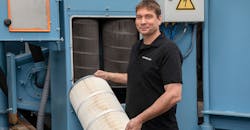Although adoption of digital technology has accelerated over the past 18 months and it is easier than ever to digitally enable existing machines, “digital foundry” projects still often ignore shot-blast equipment. The potential impact of the latest digital tools is particularly great in foundry settings, where they support smooth, continuous processing and slash the energy, abrasive media, and maintenance costs of high-powered shot-blast machines.
What is digital shot blasting?
Digital shot blasting applies process data to improve blasting performance beyond what’s currently possible. That means building up a wealth of data on a specific process so machine operators and managers can analyze and learn from it. Most important, it supports real-time process parameter tracking and alerting, so operators can intervene before a minor issue becomes a major problem.The results are smoother operation, a more stable process, more efficient use of energy and resources, and a better understanding of the condition of the machine and its components. As well as improving blast results and finished-product quality, “digital” helps make blasting operations more efficient, productive, and sustainable over time.
Current digital applications monitor process parameters and tackle the main shot-blast cost drivers but there’s vast additional potential to improve process control and traceability in foundries. Once you’ve digitally enabled a machine and start collecting, storing and analyzing process data, it’s easy to take the next step: add further sensors, run extra analyses or add new digital applications.
Enabling existing equipment
Older shot-blast machines can be digitally enabled easily by adding a network gateway. These edge devices collect data from PLCs, sensors, and other selected sources and send them to a central place for monitoring, analysis, and storage.
Norican’s NoriGate is one example. Equipment-agnostic, it works on Wheelabrator and other manufacturers’ shot-blasting machines. Most important though, it is exactly the same hardware that DISA employs to digitize molding equipment and plugs, seamlessly, into the same software (if desired.)The live data can be stored in an existing Industry 4.0 system or a cloud application, like Monitizer® | DISCOVER. Through it, data can be accessed, viewed, and analyzed on easily configurable dashboards or using pre-set tools.
If data is collected and viewed across a whole foundry, shot-blast data not only helps improve blast operations but may give insights into other parts of the process too.
First: cut shot-blast costs
Starting out by using digital to reduce blasting costs delivers the biggest gains early on, rapidly covering the cost of the initial digital installation. This rationale produced a set of ready-made digital tools now in use in Europe and shortly to arrive in the US. Built on the Monitizer platform, they tackle the top three cost drivers in shot-blasting: energy use, abrasive consumption, and maintenance.
But the benefits extend well beyond those three metrics. Optimizing abrasive consumption can shorten cycle times, save energy, and reduce wear while cutting energy use (through the clever management and minimization of idle time) and maintenance can free up capacity and maximize productivity.
Beginning in this simple way helps operators, production managers and engineers learn more about their process and how to extract knowledge from the data – expertise they can apply and extend in future. Monitizer | DISCOVER empowers them further, helping them build their own dashboards and tools without specialist programming knowledge and apply them across the whole molding line. When skilled workers on the factory floor can create the tools they need themselves, it’s the fastest way to embed data-driven continuous improvement.
Look inside the black box
With digital, foundry operators and managers suddenly see what’s going on inside their shot-blast machines in real time. They can not only understand and improve their blasting process, but also can document and prove its performance to their customers, for cross-referencing with quality control data, etc.
They can keep shot-blast equipment on the right course at all times, saving money and resources while continuously improving operating performance. Zooming out, managers can compare how different machines perform and start data-driven optimization across whole lines or sites. The operators are no longer bound to simply accept the machine’s needs and behavior. Instead, they can take charge of the process and drivie it in the direction they want to go.
Understanding blast machine effectiveness
This data-based transparency opens up wider opportunities. For example, Wheelabrator’s latest tool (again, retrofittable to all types of blast equipment) displays a blast machine’s overall effectiveness across all shifts and runs.
Foundry managers can instantly see operating status history: exactly when and for how long the machine is not running and why (idle times, maintenance breaks, loading/unloading, unscheduled downtime, delays on the line.) They can track inefficiencies and hold-ups and relate these to factors like changes to machine settings or blast media supplier, product changeover, shift changes or supply issues on the line.
This is particularly useful in modern foundries where shot-blast machines often are integrated with continuous lines and issues with blast operations may impede overall production efficiency, or indicate problems elsewhere. Why does the blast machine have longer idle periods on a Monday? Why are there more machine faults for runs of a certain pattern?
Key metrics and benchmarks make comparisons and quick troubleshooting simple, helping to optimize utilization, improve production flow and planning, and resource use. Wear, operating costs, efficiency and productivity all benefit.
What’s next?
These digital tools are effective, but only a starting point. Their delivery platform (Monitizer) is already capable of running even more advanced digital technologies, such as artificial intelligence (AI.) These are already proven to reduce scrap in foundry settings such as moulding lines.
Applied to shot-blast equipment, these advanced digital tools can cut maintenance (through AI-driven early warning systems, for example) and offer significant potential for cost savings. They could even eliminate unscheduled downtime entirely. For maintenance-intensive equipment like shot-blast machines, this could be a game changer.
Advanced process control tools for high-spec blasting processes have enormous potential, with almost no limit to the number and type of data feed they can process. Ultimately, this means operators and managers will be able to offer complete process assurance to customers, as well as achieve new levels of precision.
The power of operators and engineers to easily create new digital solutions and dashboards, tailored to their process and requirements, will increase. That – plus the ease of collaboration using digital tools – will make it much easier to ask for help and troubleshoot, whether it’s quickly getting expert advice from an OEM engineer or from the leading expert within the organization.
The opportunities digital shot blasting can unlock for foundries are vast. Yet the digital tools on offer are easy to deploy, straightforward and offer quick payback. What comes next will change foundry blast operations forever – and for the better.
By finally overcoming some of blast equipment’s historic challenges, digital technology will put operators in the driving seat, give them greater control, a more modern working environment and greater scope for collaboration and learning.
Ultimately, they will help build a sustainable, profitable future for foundries, with connected production environments that are smarter, leaner and cleaner – and empower the people working within them.
Brian Kuptz is Sales Director – Americas at Wheelabrator. Contact him at [email protected], or visit www.wheelabratorgroup.comAbout the Author
Brian Kuptz
Sales Director – Americas
Brian Kuptz is Sales Director – Americas at Wheelabrator. Contact him at [email protected], or visit www.wheelabratorgroup.com


